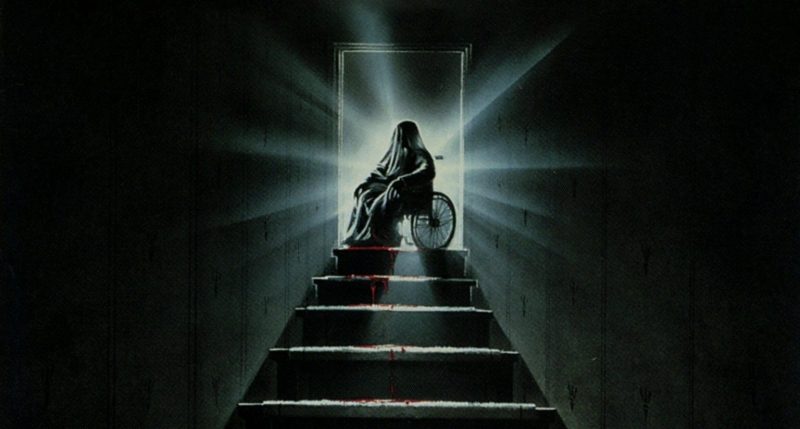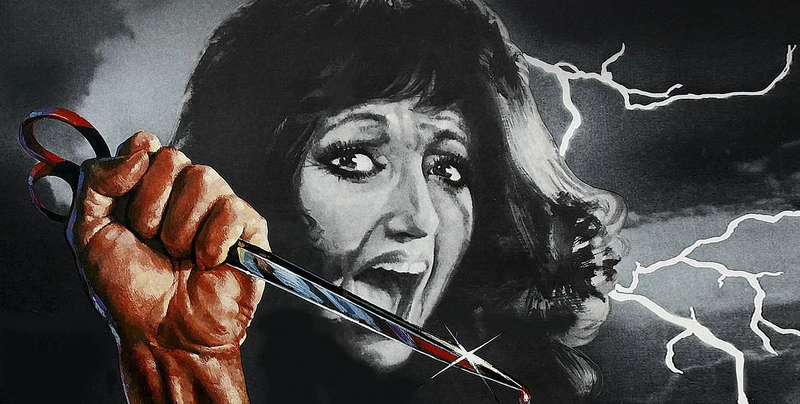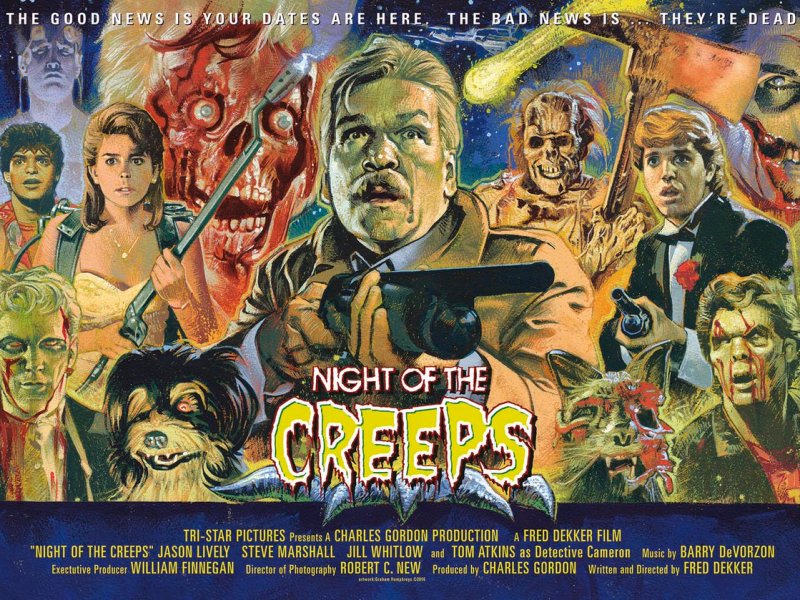
Director: Robert Hiltzik
15 | 1h 24min | Horror, Slasher
The slasher has served up its fair share of twists throughout the years, a shock reveal pretty much a prerequisite for a sub-genre that is otherwise largely predictable. Golden age slashers were typically the product of opportunistic indie producers looking to strike while the commercial iron was at its most searing. Most were done on the cheap, sticking to a rigid creative formula that cared little for artistic integrity. Even some of the genre’s better efforts were formulaic exercises in commercial chancery, but the most memorable found some way to distinguish themselves in the minds of a generation raised on a diet of fatal debauch and unprecedented cinematic violence.
Some of those films smacked us in the face with left-field twists that were designed to set tongues wagging. Triggering the deluge of like-for-like productions, the original Friday the 13th pulled the proverbial rug out from under us by subverting expectation, swapping your typical stalk-and-slash villain for a vengeful mum in a knitted sweater. Arriving when the sub-genre was still very much in its infancy, the film relied on classic whodunnit suspense for the most part, but its legacy is all in the reveal. Years after Pamela had been replaced with indestructible killing machine Jason Voorhees, Friday the 13th Part V: A New Beginning introduced an imposter killer less than a year after Paramount promised to put the series to bed amid a critical and parental backlash. Looking back, guilty party Roy Burns is so obviously the killer, thanks in large part to two consecutive vengeful-eyed close-ups in as many seconds, but Paramount’s swerve was so underhanded that you couldn’t see it coming as an identical masked figure clocked up the usual body count.
Other entries, like Canadian slasher Happy Birthday to Me, relied less on underhanded commercial chicanery, more on gobsmacking absurdity to leave us scratching our heads, revealing the killer’s identity with a double twist that put Mission Impossible‘s face-swapping antics to shame (that movie is so gloriously out there). Arguably the cleverest twist of all occurred in Fred Walton’s quasi-slasher April Fool’s Day, a film that ditched its entire final act in response to horror movie censorship, living up to its title by delivering the cinematic equivalent of a painstakingly orchestrated practical joke. Not only were we fooled by the killer’s identity, there was no killer, or any real deaths for that matter. A slasher in which nobody dies! It was unheard of!

The sheer deluge of generic slashers saturating the market made it almost impossible to shock audiences who had grown accustomed to a very strict formula by the early 1980s, but there were other, less mainstream exceptions. Also known as Nightmare Vacation, 1983’s Sleepaway Camp is a very different animal — different in the sense that it not only relies on its twist, it lives and dies by it, and does so to the extent that I doubt I would be writing about it had it whimpered out along that same generic path.
It is because of that twist — one of the most shocking and unexpected in all of low-budget horror cinema — that the movie would go on to spawn several increasingly self-aware sequels, achieving the kind of cult status most schlock can only dream of. So monumental is the movie’s shock reveal that it has made an icon out of Felissa Rose, a then-teenage actress whose other notable silver screen appearances include super low-budget gore flicks Psycho Sleepover and Aliens vs. A-holes (and no, I hadn’t heard of them either). Today, Rose is a scream queen to rival the best of them, consistently appearing at horror conventions where fans queue to get a selfie with her most famous character, and she owes it all to her primitive debut turn.
With its Friday the 13th aesthetic and summer camp retreat, Sleepaway Camp is very much in the Sean Cunningham mode, and one look at the titles of its first two sequels tells you that Jason was very much the blueprint for the series going forward. 1988‘s Sleepaway Camp II: Unhappy Campers and 1989‘s Sleepaway Camp III: Teenage Wasteland were as ludicrous and self-knowing as Friday’s post-Jason Lives entries, ramping up the slaughter and transforming the original film’s protagonist into a relentless pop culture killer. Neither of those sequels starred Felicia Rose, the infamous Angela Baker instead played by yet another cult favourite in Pamela Springsteen, and if that surname strikes you as familiar it’s because Pam is in fact the sister of iconic Born in the USA rocker Bruce, another interesting titbit unique to this obscure little franchise, but even with that unlikely distinction, Springsteen doesn’t come close to Rose in terms of horror fandom. You know why? Because of THAT twist.
Ironically, Rose auditioned for John Huston’s musical comedy drama Annie just prior to landing the lead in Robert Hiltzik’s cult slasher. Not only was Sleepaway Camp a wild departure from what she expected tonally, it cast her somewhat against the grain. It was rare for a thirteen year-old girl to land the lead in a sub-genre that relied so heavily on nudity and titillation. Unlike the majority of its contemporaries, the film uses a genuine cast of adolescent actors instead of the usual adults-playing-teenagers, so it is understandably light in that department, but the film’s twist was still a daunting prospect for a child actor who would have to face friends and family following a scene so twisted it involved her switching bodies with a much older boy in order to achieve the desired visual effect. “It was definitely strange. But I thought it was an interesting twist,” Rose would say. “There was a mould made of my face and they put it on some college boy’s body. The poor guy had to get drunk so he could get through it… My whole class came to see [the film] with me opening night. I think they were probably stunned. I don’t remember anyone saying anything about it. They just seemed to think it was really cool.”

It’s unlikely that kids would react the same way in 2021. Such a reveal may have inspired humour and even playful disgust back in 1983 (though that final image left me frozen as a twentysomething on an otherwise uneventful late afternoon) but kids, and folk in general, are much more enlightened almost forty years later, particular when it comes to gender. The world will always be fearful enough to harbour bigots, but same sex marriages, bi-sexuality, cross-sexuality, transvestism and transgenderism invite open discourse in the 2020s. They’re not the dirty little secrets they once were, and certainly not subjects that are shoehorned-in to a low-budget movie solely for shock value.
Sleepaway Camp wasn’t the first horror to broach such subjects in such a manner, it just pushed the envelope, particularly with its decision to use children. Fear of the unknown is a staple of horror, and back in the day the majority of people were genuinely terrified of anything that crossed gender boundaries. 1960’s Psycho, a whimsical horror classic with an antagonist who dressed as his mother in order to live out his murderous, sexually motivated intentions, is perhaps the most famous movie to exploit such issues. During the movie’s finale, the otherwise introverted Norman Bates is locked in a padded cell for his psychosexual exploits. The fact that he also murdered six people seems almost secondary.
In 1980, Hitchcock homage-maker and controversy-magnet Brian De Palma was hammered by women’s groups for Dressed to Kill, a stylish thriller with another cross-dressing lunatic who they claimed gave transvestites a bad name. During the film’s initial release, activist group Women Against Violence in Pornography and Media took to the streets in protest, distributing leaflets and arguing, “The distorted image of a psychotic male transvestite makes all sexual minorities appear sick and dangerous.” Described as “disconcertingly retrograde” in regards to its understanding of trans issues, The Guardian’s Scott Tobias would write of the film, “There’s no getting around the ugly association of gender transition with violence, other than to say that it feels thoroughly aestheticized.” Discussing the film through a modern context in 2014, De Palma would say, “I don’t know what the transgender community would think [of the film now]… Obviously I realize that it’s not good for their image to be transgender and also be a psychopathic murderer. But I think that [perception] passes with time. We’re in a different time.”

Though not in the same league as those movies, Sleepaway Camp is a particularly memorable entry in the slasher canon for similar reasons. You may have seen some wacky shit in your life, especially in the unscrupulous realms of slasherdom, but nothing will prepare you for such a left-field absurdity. It knocked me senseless. If you haven’t seen the movie, I suggest you close this page, grab yourself a copy and experience it for yourself. It’s one of those films that you just have to see, even if you’re not a slasher fan and the first two acts are destined to bore you senseless.
Sleepaway Camp may not have the creative pedigree or mainstream pull of some of its high-profile contemporaries, which means you’re unlikely to hear too many protestations regarding its content (to be honest it’s all a bit too ridiculous for anyone to care). I’m sure it has the capacity to offend, but the moment in question is so abrupt and startlingly out of the blue that you barely have a chance to register anything but shock as you try to figure out exactly what you’ve just witnessed. For a moment you’ll think you’ve imagined it. Bear in mind, this was a mostly bog-standard outing filmed on a minuscule budget of roughly $350,000 which somehow managed to gross $11,000,000 at the US box office at a time when slashers were experiencing something of a commercial downturn. The reason? Word of trembling mouth.
“The way I developed the idea was, I started with a beginning and an ending,” writer/director Hiltzik, who like many aspiring filmmakers at the turn of the 80s saw the hugely popular slasher as a cost-effective way to break into the industry, would explain. “I developed the ending almost first. The idea was, have a good beginning that grabs the audience, and then have a shocking ending so that when they leave the theatre they are talking about your movie. So, I came up with a beginning and an ending, and then I filled in the middle. The ending wasn’t influenced by anything in particular, other than needing to come up with something with a big twist; that is going to shock the audience. And, hopefully they don’t see it coming.”
He certainly got the ending right, even if everything else Sleepaway Camp has to offer is seeped in convention. Slasher fans aren’t a picky bunch. They know what they’re in for and experience those films for the sheer thrill of it rather than harbouring any critical pretensions. Sleepaway Camp is somewhere in the middle quality-wise, its now infamous twist the blast of nitrous oxide that propels it to somewhere on the fringes of the leading pack. This one is a late, late bloomer. In fact, you may feel a rather heavy and prolonged sense of déjà vu until Hiltzik’s calculated reveal slaps the taste out of your mouth, but if you don’t make it to the end you’re doing yourself a severe injustice.
The film features a familiar cast of promiscuous teens, a bunch of horny jocks and a token bitch who’s just asking for it in the worst way imaginable, only this time we’re not dealing with an escaped mental patient or the kind of ludicrously resourceful psycho who managed to survive undetected in the woods for years on end. You thought Pamela Voorhees was an audacious sleight of hand? You ain’t seen nothing yet.

We open with your typical childhood trauma, two kids bearing witness to a boating accident that results in a man’s death, but this being the early 1980s, the true root of the trauma is tied to sexuality. Before the reveal that sparks the kind of questionable über-reveal that would go down like an elephant in cement boots in today’s multi-sexual climate, we have your standard stalk-and-slash picnic to feast upon, though don’t expect too much in the severed head and broken bones department. The film provides us with the prerequisite kill scenes, but it knows its limitations. $350,000 can be a lot or a little in the practical effects department. Here it’s next to nothing. The best of the bunch isn’t a death but a bubonic scalding, a wholly deserving fate for a flagrant paedophile character who simply wouldn’t exist in today’s enlightened society, at least not in this context. The fact that he talks so openly about his warped intentions is almost as shocking and tasteless as the movie’s infamous pay-off. The film sure has its questionable moments.
Eight years have passed since our tragic prologue, and one of the witnessing kids is so traumatised they’ve become something of an introvert, which makes them the prime candidate for your usual adolescent bullying. Those characters are exactly what you’d expect, but Sleepaway Camp throws up a couple of doozies amid so much generic fodder. There’s Mel (Mike Kellin), a cigar-chomping camp owner who goes to quite astonishing lengths to keep a growing series of ‘accidents’ under wraps instead of simply closing the camp and saving a multitude of lives in the process. Plot chasms are part and parcel of a sub-genre that feeds on contrivance, but Mel turns the kind of neglectful corner that would leave parents reaching for the pitchforks and flaming torches. Not only is he semi-responsible for the entire ordeal, he canoodles with a camp councillor more than half his age and practically beats Angela’s barely-teenage cousin to death with his bare hands after somehow suspecting him of the camp’s grisly spate of murders. In any other reality they’d be rolling out the prison wagon, but Mel is closer to solving the mystery than you may think. If anything he’s undershooting in the outrageous accusation stakes.
Then there’s Angela’s wildly eccentric aunt, Martha Thomas (Desiree Gould), the kind of woman you imagine Mrs. Bates would have been in her younger days, and that’s not the only comparison one might draw with Psycho as the sordid mysteries begin to unravel. Martha is a high-pitched, quasi-androgynous control freak with wild eyes and the kind of shrill diction that leaves you feeling light-headed, as does her decision to inflict one of the longest, most dubiously convincing acts of child abuse one could dare to imagine. She’s like the female equivalent of Alex’s Post-Corrective Advisor P. R. Deltoid in Stanley Kubrick’s A Clockwork Orange, harbouring a peculiar passive-aggressiveness that inhabits an ethical grey area. They say there are no small parts, only small actors, and in a strange and unsettling way that description can certainly be applied to Gould’s sparse screen time. I certainly won’t be forgetting her in a hurry.

Making almost as big of an impression with considerably more screen time is Paul DeAngelo’s good-hearted camp councillor, Paul, though he’s mainly memorable for his scandalously skimpy attire. This a slasher movie, and with a cast this young I suppose you’ve got to find your titillation somewhere. Whatever floats your boat, I guess.
As a straight-up slasher, it’s by-the-numbers stuff until the final act, with a series of uninspired kills that lack the visual prowess of other hack and slash vehicles and a plot that can’t get to its reveal quick enough. Fortunately, it will make up for those inadequacies and then some. Filmed during the sub-genre’s autumnal peak, Sleepaway Camp also has a decent grasp of POV suspense, executing the kind of restraint that would all but vanish in the ensuing years, but with a pay-off of this magnitude, restraint not only has to be considered, it is absolutely essential. A timescale analogy of the movie might compare the first 85 minutes to a sexually repressed inmate strapped to a bed while a lap dancer bounces her naked breasts barely an inch from his face. As for that last minute, there is simply no comparison to be drawn.
Those who have experienced Sleepaway Camp in its entirety will no doubt question the moral decency of the film’s pay-off, particularly through the lens of modern sensibilities. That kind of shit may have flown in the 80s, but there’s not a chance in hell that twist would have made it to the screen well into the 21st century. In an era of increased enlightenment, the film has, to a lesser extent, come under fire for its handling of transgender groups and a complete absence of sensitivity regarding issues that are wholly unsuited to the exploitative realms of bargain-basement horror, something that came as a surprise to Hiltzik, “My understanding is that [the trans community] embraces the film,” he would claim. “I’ve never been introduced to that criticism. I’m surprised by the lack of criticism.”
He’s not the only one.
Just Desserts
Having been sexually harangued by unconscionable kiddie fiddler and camp gruel purveyor, Artie (Owen Hughes), Angela escapes to the safety of the great outdoors.
But what’s that? An unseen presence stalks our much deserving future victim in POV mode? Well, I never! Unfortunately for our resident cook, it doesn’t stop there, his scalded skin soon bubbling under a steaming pot of his own culinary bilge.
Double yuck!
Growing Pains
Spoiler alert! Spoiler alert!
And when I say spoiler I mean look away now, because you will never in your life forgive me for stealing this shock of all shocks from under your nose. As it transpires, the real Angela did not survive the movie’s opening tragedy at all. Instead, her brother Peter was forced to dress up as the girl crazy aunt Martha so desperately wanted, FOR HIS ENTIRE ADOLESCENCE!!!
Now put yourself in his position. If you were forced to cross-dress your way through elementary school, what would become of you? Would you grow somewhat introverted? Would you take the tragic option of suicide? Or would you develop so much hair on your body that you resembled the long-fabled missing link between simian and man? If it’s the latter, you would likely also run around camp with your chopper out, holding your peewee sweetheart’s decapitated head in your bloodied hands and growling like a rabid bear.
Yes, ladies and gentleman, Angela had a set of testicles all along. Now, would it be accurate to assume that you didn’t see that coming?
I Too, Have a Father
Time for a cooler.
Interesting fact: the role of camp owner Mel would be Tony Award nominee Mike Kellin’s final performance prior to his passing.
Sleepaway Camp would also provide a late, minor role for The Sting‘s Robert Earl Jones. And yes, he is related to Mufasa. And Darth Vader for that matter. In fact, he’s his father.
Choice Dialogue
Okay, prepare yourself for shock number… what is it now?
After spying the camp’s latest batch of nubiles, resident nonce Artie has some rather disconcerting words for his fellow summer camp employees:
Artie: Look at all that young fresh chicken. Where I come from, we call ’em baldies. Makes your mouth water, don’t it.
Ben: Artie, they’re too young to even understand what’s on your mind.
Artie: There ain’t no such thing as being too young. You’re just too old.
Once again, words fail me.
A decent, by-the-numbers slasher elevated to cult status by one of the most shocking and unexpected reveals in genre filmmaking,
Edison Smithis a must see for not only slasher fans, but anyone with a morbid fabric in their being. Rumour has it that Jason Voorhees would develop a severe case of penis envy after watching Sleepaway Camp. No wonder he harboured such rage.




































If that first movie poster on the left isn’t suggestive, I don’t know what is
LikeLike
Hahaha
I know, right? I didn’t come across it until recently.
LikeLike
Interesting (and long) article…& thoroughly enjoyable!…of note: The kitchen helper is played by a relative of actor James Earl Jones.
LikeLike
Thanks, Fraylon!
Yes, I believe it’s his father Robert Earl Jones. I mention it in the second section of the article (perhaps you didn’t read beyond the body of the article, it is long I know but I try to be as thorough as possible because you just don’t find long form articles on films like this and I always felt they needed to be out there).
Sleepaway Camp is a unique entry in the slasher canon to say the least, and yes it’s all about THAT reveal. I remember when I first saw it at university. I knew absolutely nothing about it and that final image turned me cold. I just wasn’t prepared for it whatsoever. They don’t make em like this anymore.
Thanks for reading, and thanks for the lovely comment. Very much appreciated.
LikeLike
Very enjoyable to read! Took me way back to my youth. I wish the acting had been better like Sleepaway camp 2 unhappy campers and sleepaway camp 3 teenage wasteland starring my favorite Angela Baker/Johnson played by Pamela Springsteen! Her kills were much more soothing and deserving. Hopefully she’ll come back at some point when this new installation of the Sleepaway camp series gets released. Don’t get me wrong Felissa Rose started it all and after meeting her I’m pretty impressed. Hopefully in future we’ll return to Sleepaway Camp where Angela can weed out the bad!
LikeLike
Thanks Thomas. And thanks for reading.
I love the Sleepaway Camp sequels. They tap into that late 80s, self-aware slasher period very smartly. Of course, the original is a classic, mainly because of that iconic twist, but the first two sequels are gold. Pamela Springsteen is perfect casting too. She totally gets it.
LikeLike
You’re welcome but can you do me a favor and and spell Felissa Rose because my phone misspelled her name. Thanks and I can’t wait to see more on this one of a kind misplaced gem in Horror movie genre.
LikeLike
Sure. No problem. I look forward to it too!
LikeLike